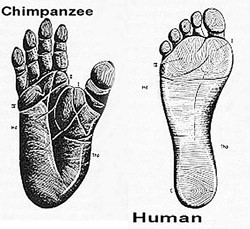Can you imagine how our lives could be if we were not walking on two legs? There are some possible reasons for the evolution of bipedalism or walking upright, which include freeing up our hands to carry food or use tools and changing habitats from the jungle to the savanna. Being bipedal also gave us many privileges, such as having a good view over the grasses, being capable of quicker change of movement, wasting less energy, and doing delicate tasks with hands. However, bipedal locomotion is complex, and the physiology is yet unclear.
Some theories of the evolution of human bipedalism
The first theory mainly suggested is the savanna-based theory. The early hominids used to live in a forest until the climate changed as forests shrank and our ancestors were required to adapt to grassland. Leaving the trees, the most adequate way to walk on the ground was on two feet (Magazine and Wayman, n.d.). The evolution of bipedal locomotion allows hominids to have a good view of the surrounding environment, hunt effectively, and be aware of predators, which would have been helpful back then. Unfortunately, this theory had been refuted by the palaeoclimatological evidence. The fossil record and several researchers state that bipedalism developed in trees (Ko, 2015).
The second theory is Darwin’s theory of evolution or simply natural selection. In 1871, Charles Darwin explained in his book that Hominids needed to free up their hands to create weapons and aim at the prey perfectly with stones and spears, which the early hominids would not have been able to perform had they used their hands for locomotion. However, this theory has a problem that the archeological record of the earliest stone tools did not show up until about 4.5 million years after the origin of bipedalism (Magazine and Wayman, n.d.). Although this is not the case, still, we have another idea with a different perspective stuck on the theory of Darwinian evolution.
As explained earlier, the climate changed, and it became harder to find food in forests. Especially, it was difficult for females that needed to raise their offspring. Thus, bipedalism evolved by freeing up their hands to allow males to be productive in collecting food and females raising their young (Magazine and Wayman, n.d.).
About natural selection, there is no specific reason for hominids to become bipedal. According to the time, the evolution of bipedalism was a beneficial quality for hominids to survive in the environment in which they lived. There is no surprise about natural selection, considering that this theory includes several factors that were mentioned, such as the effective protection of offspring, better food collection , and the effect of climate changes (Ko, 2015).
Advantages/disadvantages of bipedalism
There are several advantages of walking on two feet. First, the free upper limbs allow us more than just carrying tools, food, and infants. It enables us to perform sophisticated tasks and have hand dexterity, which is a huge advantage (Kroker, 1999).
Second, bipedalism allowed early hominids to see over tall grasses and watch out for predators. Also, it gives hominids the ability to make a quick shift in position in all directions, and if they need an exigent acceleration or deceleration, it can be realized through bipedalism (Kroker, 1999). Furthermore, most importantly, through bipedalism, we consume less energy than we would if we were walking on four feet. In 2007, according to (Magazine and Wayman, n.d.), the researchers of chimpanzees affirmed that chimps demand 75% more energy than bipedal humans while walking, allowing them to travel long distances.
Disadvantages of being upright are:
Firstly, we lost our ability to climb trees efficiently. Look at this image below. This is an image of a chimpanzee (a kind of hominid similar to us) and a human foot. Our big toe is not able to grasp branches as well as chimpanzees can when climbing trees, which is a necessary skill for them to be able to collect fruit and get away from predators.

As humans’ big toes are in line with the rest of their toes, it makes it easier for them to push their foot off the ground to walk. On the other hand, chimpanzees’ big toes are different from ours and ideal for grasping and climbing trees (alnorwo1, 2016).
Secondly, upright gait requires a highly developed structure for balance, with proper adjustment of muscle tone and contraction and rapid union of various sensory inputs from the eyes, inner ears, and internal position sensors (Kroker, 1999).
Moreover, while standing on two legs makes it easier to balance, you can frequently feel pain in your lower back due to weakened muscles or illness (alnorwo1, 2016).
Conclusion:
Bipedalism evolved at least 7 to 4 million years ago; however, the question of why bipedalism evolved is too complicated. The savanna-based theory or the Darwinian theory might be close to an answer. They could both be wrong, and the real answer is a combination of both theories. Nevertheless, we will find the true answer if paleoanthropologists find more fossils of the earliest hominids. Any small or big discovery has the capability of changing how we understand their traits.
Reference list:
alnorwo1 (2016). The ups and downs of two-legged walking. [online] Ask An Anthropologist. Available at: https://askananthropologist.asu.edu/ups-and-downs-two-legged-walking.
Economy and Endurance in Human Evolution. (2017). Current Biology, [online] 27(12), pp.R613–R621. Available at: https://www.sciencedirect.com/science/article/pii/S0960982217305675.
Ko, K.H. (2015). Origins of Bipedalism. Brazilian Archives of Biology and Technology, 58(6), pp.929–934.
Kroker, P. (1999). The problem of remaining upright. BMJ : British Medical Journal, [online] 319(7220), p.1300. Available at: https://www.ncbi.nlm.nih.gov/pmc/articles/PMC1129077/.
Magazine, S. and Wayman, E. (n.d.). Becoming Human: The Evolution of Walking Upright. [online] Smithsonian Magazine. Available at: https://www.smithsonianmag.com/science-nature/becoming-human-the-evolution-of-walking-upright-13837658/#:~:text=Walking%20upright%20on%20two%20legs.
